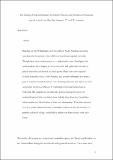Files in this item
The making of regional systems : the Tapajós/Madeira and Trombetas/Nhamundá regions in the lower Brazilian Amazon, seventeenth and eighteenth centuries
Item metadata
| dc.contributor.author | Harris, Mark | |
| dc.date.accessioned | 2018-11-07T11:30:15Z | |
| dc.date.available | 2018-11-07T11:30:15Z | |
| dc.date.issued | 2018-10-01 | |
| dc.identifier | 256370022 | |
| dc.identifier | 65a65869-707f-4e7b-9557-c019df285463 | |
| dc.identifier | 85055573185 | |
| dc.identifier | 000447380300005 | |
| dc.identifier.citation | Harris , M 2018 , ' The making of regional systems : the Tapajós/Madeira and Trombetas/Nhamundá regions in the lower Brazilian Amazon, seventeenth and eighteenth centuries ' , Ethnohistory , vol. 65 , no. 4 , pp. 621-645 . https://doi.org/10.1215/00141801-6991274 | en |
| dc.identifier.issn | 0014-1801 | |
| dc.identifier.other | RIS: urn:A7819E59486ED400D042ADA26B7AEE85 | |
| dc.identifier.other | ORCID: /0000-0003-1124-5217/work/50167349 | |
| dc.identifier.uri | https://hdl.handle.net/10023/16409 | |
| dc.description | The author is grateful to the British Academy and the Leverhulme Trust for their financial support. | en |
| dc.description.abstract | Building on Neil Whitehead’s work in northern South America, this article considers the formations of two different deep-forest regional networks. Though these Amerindian spaces have origins in the precolonial past, this article analyses their shaping in the seventeenth and eighteenth centuries, a period when they were invaded by colonial agents. There were other regional systems along the course of the Amazon and its many tributaries that were a part of a similar historical process of refounding identities and claims on land and people involving challenges to leadership and political organization. Following Hal Langfur, we can term this general making of spaces a re-territorialization. Critical social relations include those between Amerindian ethnic entities and their leaders, soldiers, and missionaries. This article focuses on a key spatial relation between Amerindian settlements and the mission, or partially colonized village, which had an indirect or direct contact with each other. | |
| dc.format.extent | 25 | |
| dc.format.extent | 551148 | |
| dc.language.iso | eng | |
| dc.relation.ispartof | Ethnohistory | en |
| dc.subject | Tapajós | en |
| dc.subject | Trombetas | en |
| dc.subject | Amazon | en |
| dc.subject | Regional network | en |
| dc.subject | Interethnic relations | en |
| dc.subject | GN Anthropology | en |
| dc.subject | T-NDAS | en |
| dc.subject | BDC | en |
| dc.subject | R2C | en |
| dc.subject | SDG 15 - Life on Land | en |
| dc.subject.lcc | GN | en |
| dc.title | The making of regional systems : the Tapajós/Madeira and Trombetas/Nhamundá regions in the lower Brazilian Amazon, seventeenth and eighteenth centuries | en |
| dc.type | Journal article | en |
| dc.contributor.sponsor | The British Academy | en |
| dc.contributor.sponsor | The Leverhulme Trust | en |
| dc.contributor.institution | University of St Andrews. Social Anthropology | en |
| dc.contributor.institution | University of St Andrews. School of Philosophical, Anthropological and Film Studies | en |
| dc.identifier.doi | https://doi.org/10.1215/00141801-6991274 | |
| dc.description.status | Peer reviewed | en |
| dc.identifier.grantnumber | SF140050 | en |
| dc.identifier.grantnumber | RPG-2012-699 | en |
This item appears in the following Collection(s)
Items in the St Andrews Research Repository are protected by copyright, with all rights reserved, unless otherwise indicated.

